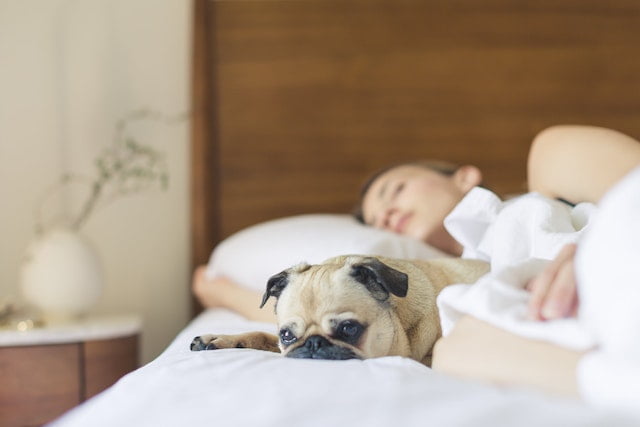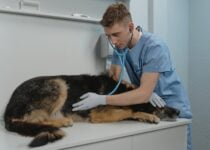Why Does My Dog Hump His Bed After Eating? The Reasons Will Amaze You! (2024)

“Why does my dog hump his bed after eating?” I have been asking myself this question so many times, and I can’t seem to get my head around this funny behavior from my dog. My dog, instead of simply humping his bed, will frequently hump on my leg and begin jamming his genital on my leg after eating. I also posted the video on my TikTok page. It’s an embarrassing sight, I know! That’s why I did some research and consulted some professionals to ascertain the reasons for this behavior. Guess what! I discovered some plausible explanations for why my dog hump his bed, people, or other animals after eating.
According to my findings, dogs are highly social animals that communicate in various ways, including through body language, vocalizations, and behaviors. One such behavior that dogs may exhibit is humping or mounting the bed after eating. This behavior involves a dog thrusting her hips and genitals against a person, object, or other animal. While this behavior is often associated with sexual arousal, it can also be triggered by other factors, such as anxiety, excitement, or boredom.
Read also>> Is sleeping with a puppy in bed a good idea?
If you’ve noticed that your dog is humping his bed after eating, you may be wondering why he’s doing it and whether it’s a cause for concern. The good news is that humping is a common and natural behavior that most dogs display at some point in their lives. In fact, it’s estimated that up to 80% of dogs will hump or mount objects or other animals at some point in their lives.
Why does my dog hump his bed after eating?
1) Response to anxiety, excitement, or stress
When a dog is anxious, excited, or stressed, he responds by scratching, digging, sniffing, panting, barking, trembling, chewing, biting, and of course, humping his bed! Humping is one way that dogs may respond to these emotional states.
Humping releases endorphins in the brain, which can help reduce anxiety or stress and create a sense of calm. This is similar to how humans may engage in activities like exercise or meditation to reduce their own anxiety.
If your dog is feeling anxious, excited, or stressed after eating, he may be more likely to hump his bed as a way to cope with these emotions. This behavior can become a habit if your dog feels that humping his bed helps him feel better. Over time, your dog may come to associate eating with humping as a way to regulate his emotional state.
2) Energy bursts
If your dog has just eaten a meal that is high in protein or calories, he may feel energized and excited. This burst of energy can be expressed in different ways, such as by running around the house, playing with toys, or even humping his bed. Humping can be a way for your dog to release some of the energy he has stored up after eating, especially if he is unable to go outside or engage in other physical activities.
3) Playful act
Humping is a natural behavior for dogs and can be triggered by a variety of stimuli. One common reason why dogs hump their beds after eating is because they are feeling playful or excited. After eating, your dog may have more energy and feel more playful, which can lead to humping behavior.
By humping his bed, your dog may be engaging in a playful act that helps to release pent-up energy and reduce boredom. Additionally, some dogs may view their bed as a “playmate” and use humping as a way to interact with it.
4) Seeking the owner’s attention
Just like humans crave attention and don’t like to be ignored, dogs, as social animals, also crave their owners’ attention and will always want to interact with them. If your dog is humping his bed after eating, it may be because he is seeking attention from you.
A dog humping his bed after eating may be a way to communicate with you and get your attention, especially if he has learned that this behavior always gets you to respond to him.
5) Hungry for more food
Some dogs may engage in humping behavior as a way to communicate their desire for more food. After eating, your dog may still feel hungry or unsatisfied, which can lead to humping behavior. Humping can be a way for your dog to communicate his desire for more food or to seek out additional sources of food.
Inadequate exercise
Dogs require regular exercise to maintain their physical and mental health. If your dog is not receiving enough exercise, he may become bored or restless, which can lead to humping behavior. Humping can be a way for your dog to release pent-up energy and reduce boredom.
After eating, your dog may have more energy and feel more restless if he has not received adequate exercise. This can lead to humping behavior as a way to release excess energy and engage in physical activity.
Female in heat period
Female dogs go through a reproductive cycle known as estrus or heat, during which they may exhibit a range of behaviors, including humping. Humping behavior during a female dog’s heat period is often driven by hormonal changes and is a natural behavior associated with the reproductive cycle.
During a female dog’s heat period, her body releases hormones that can cause her to exhibit humping behavior. This behavior is typically directed towards objects, such as toys or bedding, rather than other dogs or people. Female dogs may also exhibit other behaviors, such as increased urination, restlessness, and changes in appetite or activity levels, during their heat period.
Habits and sleep routine
Dogs are creatures of habit and often rely on routine to feel secure and comfortable in their environment. If your dog has established the habit of humping his bed after eating or as part of his sleep routine, he may continue to do so out of habit or a desire for routine.
After eating, your dog may engage in humping behavior as part of his established routine or habit. This behavior may provide a sense of comfort or security for your dog and may be difficult to break without changing his routine or providing alternative forms of comfort.
Medical issues and health
Humping behavior in dogs can sometimes be a sign of underlying medical issues or health problems. Certain medical conditions, such as allergies, skin irritations, or urinary tract infections, can cause dogs to engage in humping behavior as a way to relieve discomfort or itchiness.
Additionally, certain medications or hormonal imbalances can also contribute to humping behavior in dogs. For example, some medications used to treat anxiety or other behavioral issues may have side effects that include humping behavior.
Read also>> How do I stop my dog from destroying his bed in his crate
How do I stop my dog from humping his bed after eating?
Here are seven vet-approved ways to stop a dog from humping his bed after eating:
1) Regular exercise
A tired dog is less likely to indulge in humping his bed, people, or other animals after eating. So, it is recommended you ensure your dog gets adequate exercise to help him release pent-up energy and reduce stress, resulting in less humping or mounting behavior.
2) Redirecting behavior
If you observe your dog engaging in humping behavior, try redirecting him to another activity that he enjoys, such as playing with a toy or going for a walk. This will help your dog learn that there are other ways to channel his energy and reduce humping on objects, humans, or other pets.
3) Positive reinforcement training
Positive reinforcement training can help teach your dog good behavior by rewarding him for positive actions. When your dog stops humping his bed after eating and instead engages in positive behavior, give him praise and rewards to encourage him to continue the good behavior.
4) Desensitization
If your dog humps on his bed after eating due to anxiety or stress, desensitization can be helpful. Introduce your dog to the situations that trigger his anxiety gradually and reward him for calm behavior, helping him to associate the situation with positive emotions.
5) Training Exercises
Several training exercises, such as “Sit,” “Stay,” and “Down” commands, can help distract your dog and reduce humping behavior. Training exercises can also help reinforce your dog’s bond with you and improve his obedience.
6) Neutering
Neutering can help reduce humping behavior in male dogs as it reduces their testosterone levels, which can cause sexual arousal and humping behavior. Although, this method works in some cases, but many professions advise against it. So it is better to consult with your veterinarian to see if neutering is an option for your dog.
7) Provide distraction
Distract your dog by providing him with a variety of toys and chew treats to keep him occupied and distracted from his humping behavior. This can help him learn to redirect his energy to other activities and reduce humping behavior.
Finally, it’s essential to identify the reasons why your dog humps his bed after eating and work with a veterinarian or a certified dog trainer to determine the best course of action to reduce or eliminate the behavior.
Why does my dog get frisky after eating?
Dogs are known for their energetic and playful behavior, and it’s not uncommon for them to become more frisky after eating. Here are some reasons why:
- Increase in blood sugar levels: When dogs eat, their bodies break down the food and convert it into glucose, which is used as energy for the body. This increase in blood sugar levels can make your dog feel more energetic and playful.
- Release of hormones: Eating triggers the release of hormones such as dopamine and serotonin, which are associated with pleasure and happiness. These hormones can cause your dog to feel more lively and playful.
- Relief from hunger: If your dog was feeling hungry before eating, it may have been restless or lethargic. After eating, they may feel more satisfied and energetic.
- Digestive stimulation: Eating can also stimulate the digestive system, which can cause your dog to get more frisky after eating.
- Breed-specific behavior: Certain dog breeds, such as terriers and spaniels, are known for their high energy levels and playful behavior. If your dog belongs to one of these breeds, it may naturally be more frisky after eating.
FAQ: Why Does My Dog Hump His Bed After Eating?
Is it normal for a female dog to hump you?
A: Yes, all dogs can hump on you, whether male or female. So it is very normal for a female dog to hump on your leg, her bed, or other animals, especially when she’s in heat.
Why does my dog hump when he’s happy?
A: When a dog becomes overstimulated or excessively excited, it may engage in humping behavior as a way to release its energy and express its emotions.
3) Do dogs hump you for attention?
A: Yes, dogs may hump their owners or other people as a way to seek attention or to initiate play, but this behavior is not the only way that dogs can get attention. Dogs can use a variety of behaviors to get attention, such as barking, pawing, or nuzzling.


